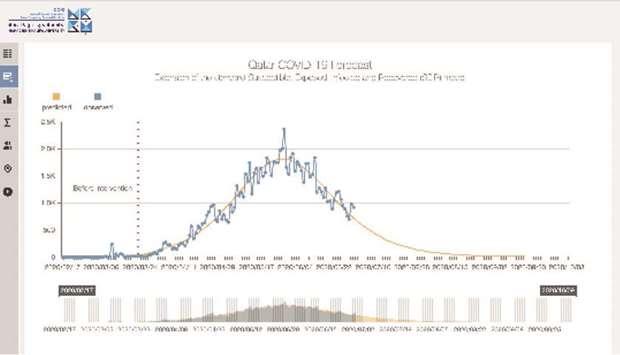From the first week of the pandemic, Qatar Computing Research Institute (QCRI) was swift to respond – they developed a system that traces the movement of people based on cellphone data.
“Our system helped the health authorities with contact tracing for Covid-19 positive patients, especially in the first few weeks of the pandemic, before the Ehteraz app was deployed,” Dr Ashraf Aboulnaga, senior research director at QCRI, explained.
The Hamad Bin Khalifa University research institute was quick to develop a portfolio of applications and tools to address national and global priorities in the fight against Covid-19, with solutions ranging from digital health tools, analysing data and facilitating literature reviews, among many others.
One such solution was to gather data related to social distancing to help policymakers.
Aboulnaga highlights the importance of measuring social distancing at the scale of the entire country, such as places visited by people more than the usual and those visited less than usual. “QCRI has developed a web-based dashboard that computes this information based on Google data and displays a map showing the reduction or increase in visits for important locations in Doha. This is valuable data that is used by the health authorities in Qatar,” Dr Aboulnaga noted.
QCRI has partnered with several NGOs to extend this dashboard to other cities such as Kuwait City, Beirut, Amman, Nairobi and Lagos.
The Qatar Foundation research institute has also developed mobile phone apps that use GPS for contact-tracing to ensure quarantined people remain within their quarantine area, as well as an online self-assessment tool that is accessible from the web or mobile phones.
“The online self-assessment tool is based on a questionnaire that helps users asses their symptoms and decide their next steps, such as seeking medical help,” Dr Aboulnaga said.
It is a web-based tool and is based on the guidelines laid out by the World Health Organisation and Hamad Medical Corporation.
A key feature of the self-assessment tool is that it is multilingual.
The tool has been very successful, Dr Aboulnaga says, with 1.3mn visits to date.
The tool is available in 11 languages and the two most popular are Arabic and Hindi.
Besides this, QCRI has also modelled and visualised the evolution of the pandemic.
The research institute created a dashboard that summarises data related to the pandemic in Qatar and the GCC countries which helps predict disease development.
“The dashboard is used by government health authorities in Qatar, and internally within Qatar Foundation,” Dr Aboulnaga said.
QCRI also strives to address false and inaccurate information that makes its way to social media – a prominent feature of today’s hyperconnected social media age where a lot of disinformation about Covid-19 is created – also known as ‘infodemic’.
“For the past few years, QCRI has been working on analysing social media and countering propaganda in the news and media,” says Dr Aboulnaga. “We adapted our technologies to help in identifying rumours and disinformation around Covid-19. We produce regular reports about social media for the health authorities and provide web-based tools to identify and analyse propaganda.”
“QCRI has a system called Rayyan that facilitates large literature reviews. It is a mature system used by 65,000 users around the world, and it has been used heavily in this pandemic,” Dr Aboulnaga said.
CORD-19 – a data set of over 150,000 scientific articles related to Covid-19 released in the US at the request of the White House and immensely valuable to researchers – is available in Rayyan.
Rayyan was also independently evaluated by a group of users in Sweden.
The results of this evaluation showed that users saved time on average more than 50%, compared to other methods and tools.
And a recent study conducted by a group of researchers from the University of Cambridge lists Rayyan among the “top 15 tools for checking titles and summaries”.

Qatar Covid situation dashboard.


